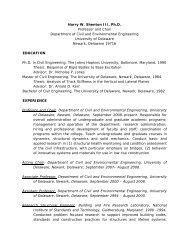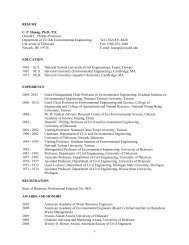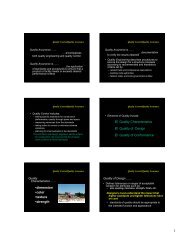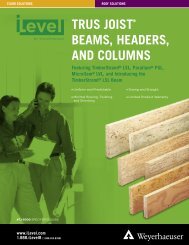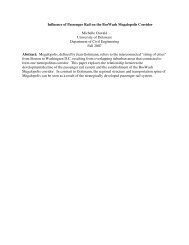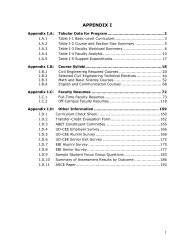Construction Management & Engineering CIEG 467-013
Construction Management & Engineering CIEG 467-013
Construction Management & Engineering CIEG 467-013
You also want an ePaper? Increase the reach of your titles
YUMPU automatically turns print PDFs into web optimized ePapers that Google loves.
<strong>Construction</strong> <strong>Management</strong> & <strong>Engineering</strong><br />
<strong>CIEG</strong> <strong>467</strong>-<strong>013</strong>
Earthwork
Soil Volume Changes<br />
wel<br />
1.25 LCY<br />
hrinkage<br />
1.0 BCY<br />
0.90 CCY<br />
Natural or<br />
In situ<br />
State<br />
Disturbed<br />
State<br />
(Loose)<br />
Compacted<br />
State
Earthwork<br />
Swell (%) =<br />
weight/bank volume<br />
weight/loose volume<br />
-1<br />
x<br />
100<br />
weight/bank volume<br />
Shrinkage (%) = 1 - x 100<br />
weight/compacted volume
Earthwork<br />
Load Factor =<br />
weight/loose volume<br />
weight/bank volume<br />
Load Factor =<br />
1<br />
1 + swell
Earthwork<br />
Shrinkage Factor =<br />
weight/bank unit volume<br />
weight/compacted unit volume<br />
Shrinkage Factor =<br />
1 - shrinkage
Earthwork Volumes<br />
• Sitework<br />
– Usually lump sum contract work<br />
– Traditional Method = averaging cut/fill<br />
depths x plan area (using a grid)<br />
– Modern Method = any number of software<br />
packages such as PAYDIRT ®<br />
– Computer programs compare the existing<br />
surfaces against various proposed<br />
surfaces i.e.: subgrade, base grade, finish<br />
grade
Earthwork Volumes<br />
• Highway & Trench Excavation<br />
– Usually unit-price line item<br />
– Traditional Method = average end area<br />
measured from cross sections by planimeter,<br />
cross multiplication, strip and tic = all very<br />
laborious<br />
– Modern Method = digitize cross sections for<br />
computation by electronic spreadsheet, or any<br />
number of software packages such as<br />
TERRAMODEL ®
Earthwork Volumes<br />
…..Highway & Trench Excavation<br />
– Some computer programs convert sections to<br />
surfaces and vice versa<br />
– Programs can prepare mass haul diagrams<br />
and other reports
Soil Behavior<br />
• Soil Density (wet or dry)<br />
• Soil Compaction<br />
• Consolidation<br />
• Moisture Content<br />
• Stability<br />
• Compressible Soils<br />
• Expansive Clays
Compaction<br />
• Increased bearing capacity<br />
• Reduce compressibility<br />
• Reduce permeability<br />
• Improve stability<br />
• Heavy/highway vs. building<br />
foundation compaction<br />
operations
Compaction<br />
Five factors affecting compaction<br />
1. Physical & chemical properties<br />
2. Moisture content<br />
3. Method of compaction<br />
4. Amount of compactive effort<br />
5. Thickness of layer or “lift” being<br />
compacted
Compaction<br />
Methods of Compaction<br />
1. Static weight<br />
2. Impact<br />
3. Vibration<br />
4. Manipulation or kneading<br />
5. Percolation
Consolidation<br />
• Primary consolidation results from the<br />
expulsion or extrusion of water from the voids<br />
in fine-grained soil<br />
• Causes settlement in structures and<br />
embankment over a period of time<br />
– Methods of accelerating consolidation<br />
include placing a surcharge and/or installing<br />
sand columns or wick drains<br />
• Secondary consolidation is the rearrangement<br />
of cohesive soil grains
<strong>Construction</strong> <strong>Management</strong> & <strong>Engineering</strong><br />
<strong>CIEG</strong> <strong>467</strong>-<strong>013</strong><br />
Mass Haul Diagrams<br />
• diagrammatic representation of earthwork<br />
volumes along a linear profile<br />
• horizontal stationing is plotted along the X-<br />
axis<br />
• net earthwork values are plotted along the Y-<br />
axis
<strong>Construction</strong> <strong>Management</strong> & <strong>Engineering</strong><br />
<strong>CIEG</strong> <strong>467</strong>-<strong>013</strong><br />
Mass Haul Diagrams<br />
• An Earthwork Profile is a plot of the net<br />
earthwork along a roadway or airstrip<br />
• Net cut values are plotted above the X-axis<br />
(positive Y value)<br />
• Net fill values are plotted below the X-axis<br />
(negative Y value)<br />
• Presents a picture of the earthwork<br />
requirements
<strong>Construction</strong> <strong>Management</strong> & <strong>Engineering</strong><br />
<strong>CIEG</strong> <strong>467</strong>-<strong>013</strong><br />
Mass Haul Diagrams<br />
• A Mass Haul Diagram is a continuous curve<br />
representing the cumulative volume of<br />
earthwork along the linear profile of a<br />
roadway or airfield<br />
• the vertical coordinate is a plot of the<br />
cumulative earthwork from the origin to that<br />
point
<strong>Construction</strong> <strong>Management</strong> & <strong>Engineering</strong><br />
<strong>CIEG</strong> <strong>467</strong>-<strong>013</strong><br />
Mass Haul Diagrams<br />
• upward sloping curves indicate (rising left to<br />
right) indicate a cut<br />
• downward sloping (falling left to right) curves<br />
occur in a fill section<br />
• peaks indicate a change from cut to fill and<br />
valleys occur when the earthwork changes<br />
from fill to cut
Mass Haul Diagrams<br />
<strong>Construction</strong> <strong>Management</strong> & <strong>Engineering</strong><br />
<strong>CIEG</strong> <strong>467</strong>-<strong>013</strong><br />
• The accumulated volume of earthwork at the<br />
horizontal axis (Y=0) is 0<br />
• When a horizontal line intersects two or more<br />
points along the curve, the accumulated volumes<br />
at those points are equal<br />
• A negative value at the end of the curve indicates<br />
that borrow is required to complete the fill<br />
• A positive value at the end of the curve indicates<br />
that a waste operation will be the net result
Mass Haul Diagrams<br />
To construct the Mass Haul Diagram manually:<br />
• Compute the net earthwork values for each station, applying<br />
the appropriate shrink factor<br />
• Net cuts have a positive value, net fills have a negative<br />
value<br />
• The value at the first station (origin) = 0<br />
• Plot the value of each succeeding station which equals the<br />
cumulative value to that point, i.e., the value at i = net<br />
cut/fill a+b+c+…i
Mass Haul Diagram
Mass Haul Diagrams<br />
To construct & analyze the Mass Haul Diagram<br />
manually:<br />
• Identify the the resulting balanced sections, which<br />
are bounded by points that intersect the X-axis<br />
• Draw a horizontal line midway between the peak or<br />
valley and the X-axis. The scale length of that line<br />
is the average length of haul within that balanced<br />
section<br />
• Determine earthwork volumes within each<br />
balanced section<br />
• Determine whether there is an overall balance,<br />
waste or if borrow is required
Earthwork<br />
Clearing & Grubbing<br />
• removal of trees, shrubs, and other vegetation<br />
• removing stumps and root mat at least 2’ (600mm)<br />
below subgrade<br />
• less removal required for embankment heights > 5’<br />
• topsoil striping<br />
• muck excavation
Earthwork<br />
Prior to starting any earthwork:<br />
• verify location of underground utilities through “Miss<br />
Utility” or local “one-call” system<br />
– check for utilities not included in one-call system<br />
– dig test pits to confirm actual locations<br />
• note location of aerial utilities for equipment and<br />
truck clearances<br />
• confirm that all applicable permits and approvals<br />
have been secured
Earthwork<br />
Prior to starting any earthwork:<br />
• Install all required E&SC devices<br />
• Review soil borings and other geotechnical<br />
information<br />
• Observe existing drainage patterns<br />
• Plan access and excavation patterns<br />
• Determine handling of spoils<br />
• Verify original ground surfaces (compare against<br />
existing contours or cross sections shown on the<br />
plan)
Keys to Successful Earthwork<br />
Operations<br />
1. control surface and subsurface water<br />
2. maintain optimum moisture range by drying,<br />
mixing , or wetting<br />
3. identify and monitor cut & fill quantities<br />
4. good layout (horizontal & vertical control)<br />
5. minimize handling - minimize stockpiling
Keys to Successful Earthwork<br />
Operations<br />
6. optimize haul lengths<br />
7. minimize cycle time<br />
8. proper selection and sizing of excavators<br />
and haul units<br />
9. alternate haul unit wheel paths<br />
10.experienced personnel in the field
Equipment Functions<br />
• Excavating<br />
• Loading<br />
• Hauling<br />
• Placing (dumping &<br />
spreading)<br />
• Drying<br />
• Ripping<br />
• Boring or tunneling<br />
• Compacting<br />
• Grading<br />
• Finishing
Equipment Classifications<br />
• Function<br />
• Configuration<br />
• Power Units -- Gas vs. diesel vs. gas<br />
turbine<br />
• Running Gear -- track (crawler) vs. wheel<br />
(rubber tire)<br />
• Activation - conventional (gears, pulleys,<br />
cable) vs. hydraulic
Diesel vs. Gas Power Units<br />
Advantages of diesel over gas<br />
• Less need for servicing<br />
• Longer life<br />
• Lower fuel consumption<br />
• Lower- priced fuel<br />
• Lower fire hazard<br />
• Low CO emissions
Running Gear<br />
Tracks<br />
• greater traction<br />
• less ground pressure<br />
• better on steep grades<br />
• not prone to damage<br />
from surface<br />
• drawbar pull<br />
Wheels<br />
• greater mobility<br />
• greater speed<br />
• does not scar or damage<br />
paved surfaces<br />
• encounters rolling<br />
resistance<br />
• rimpull force
Traction<br />
Rolling Resistance Factor (lb/ton) = 40 + ( 30 x in. penetration )<br />
Rolling Resistance Factor (kg/t) = 20 + ( 6 x cm penetration )<br />
Grade Resistance Factor (lb/ton) = 20 x grade (%)<br />
Grade Resistance Factor (kg/t) = 10 x grade (%)
Traction<br />
Grade Resistance (lb) = GVW (tons) x Gr. Resistance Factor (lb/ton)<br />
Grade Resistance (kg) =<br />
GVW (t) x Gr. Resistance Factor (kg/t)<br />
or<br />
Grade Resistance (lb) =<br />
GVW (lb) x Grade<br />
Grade Resistance (kg) =<br />
GVW (kg) x Grade
Excavation Equipment
Excavation Equipment<br />
• Hydraulic Excavators<br />
• Backhoes<br />
• Draglines & Clamshells<br />
• Telescoping-boom<br />
Hydraulic Excavators<br />
• Dozers/Tractors/Rippers<br />
• Front End Loaders
Excavation Equipment<br />
• Scrappers (pans)<br />
• Trenchers<br />
• Boring/Tunneling<br />
• Motor Graders<br />
• Auto Graders<br />
• Compaction Equipment<br />
– Rollers & Tampers
Hauling Equipment
Excavation Equipment
Excavation Equipment
Excavation Equipment
Compaction Equipment
Erosion & Sedimentation<br />
Control Devices
Erosion & Sedimentation<br />
Control Devices<br />
Also referred to as “construction practices”<br />
• Silt fence – plain or reinforced<br />
• <strong>Construction</strong> entrances<br />
• Stone or rock check dams<br />
• Earth berms<br />
• Sediment traps – single or multi-stage<br />
• Dewatering devices<br />
• Straw-coconut blankets<br />
• Seeding & mulching – establish vegetation<br />
ASAP
Slope Stability<br />
• Function of the natural angle of repose, density,<br />
surface and subsurface water flow<br />
• Early stabilization of surfaces is critical i.e.<br />
seeding, mulching, erosion blanket<br />
• Upward tracking of slopes slows sheet flow<br />
• Eliminate points of concentrated flow using<br />
berms or using slope drains as outlets<br />
• Slopes can be “softened” if space permits<br />
• Difficult slopes may require riprap, gabions, or<br />
other measures for permanent stabilization
Riprap<br />
• Riprap placed on geotextile and crushed<br />
stone cushion<br />
• Placed by excavator or clamshell, arranged<br />
by hand<br />
• Unit price in tons or SY (SM)
Benching<br />
• Benching is used to properly patch or extend<br />
a slope<br />
• Benching is also used to temporarily support<br />
equipment for other work elements<br />
• Bench detail must be wide enough to support<br />
a dozer % slope in towards the roadway to<br />
resist sliding





